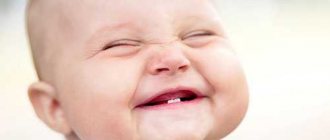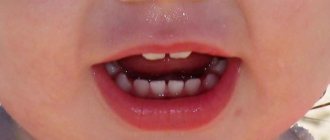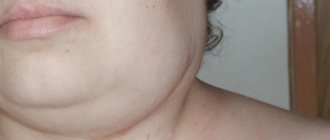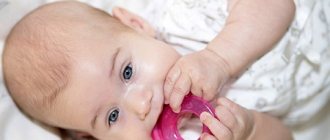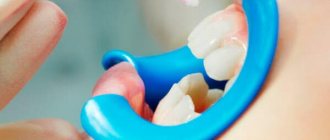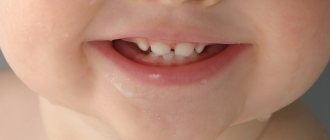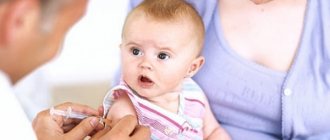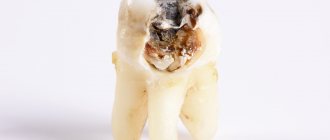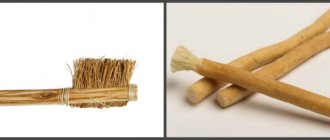Causes
It should be understood that an increase in the temperature threshold is a consequence of deep changes
. To break through, a tooth has to overcome the resistance of several layers of tissue. First it is the bone tissue of the jaw, and then the gum itself.
The tissues perceive it as a foreign body, give a signal to the immune system and the number of leukocytes in the blood increases. That is, inflammation occurs
. Immunity decreases, and the body directs all its forces to secrete antibodies to fight the “enemy”.
The temperature is at 37-37.5 and there is a signal that the production of antibodies has begun. It is not harmful to the child, but rather necessary. There is absolutely no need to reduce the fever if the upper limit is not higher than 38 degrees
. It will drop to normal levels on its own when the body gives a signal that the internal struggle has been successful.
Additional symptoms
Temperature may be accompanied by several other important signs of teething, such as:
- Increased salivation;
- Loose stools;
- Swollen gums;
- Runny nose;
- Cough;
- Redness of the cheeks and neck;
- Enlarged lymph nodes.
It is necessary to look at each of these symptoms individually to understand how they relate to teething. It is worth knowing how some manifestations are associated with risks, and how to recognize a moment of danger.
Saliva
is a natural antiseptic; its release helps prevent infection from entering tissues and developing more serious consequences. Violation of the integrity of the gums by the emerging tooth is disinfected by saliva, and tissue regeneration occurs faster.
Runny nose
occurs due to the proliferation of pathogenic bacteria in the nasopharynx cavity, as immunity decreases. The respiratory organs also become inflamed and try to fight off the infection. Lymph nodes enlarge as with any infectious disease, when the body's defenses work harder.
Bacteria also spread to the gastrointestinal system, so bowel problems may occur in the form of diarrhea.
. Frequent swallowing of saliva is also a common cause of diarrhea.
Two or three times in a row is already the beginning of dehydration of the body, it’s time to take emergency measures to take medications against dysbiosis.
Want to know how children's teeth grow? Read our article and see photos.
Let's find out how to cure tonsillitis in a child at home.
At this address: https://www.vash-dentist.ru/detskaya-stomatologia/d-zubi/prorezyivanie-z/primernyie-sroki-molochnyih.html - you will find a table with the average time for the eruption of baby teeth.
Cough
may be rare, with pharyngeal contents being rejected. Saliva is swallowed and irritates the throat, so the nature of the cough is specific - hysterical. It also happens that a cough provokes a gag reflex. If you have a frequent cough, you should examine your child for acute respiratory infections.
With any inflammation, blood flows to the sites where leukocytes fight infection. This causes redness of the skin in the gum area
. In addition, the child often rubs and touches these places, exacerbating their redness. Red and swollen gums are a sign of inflammation in the mouth.
What else mothers should know about teething in their children - watch the video:
Temperature during teething in a child
Teething is a serious stress for a child’s body, to which it can respond by increasing body temperature. However, such a symptom in infants is not always associated specifically with teeth. From our article you can find out whether the temperature during teething is dangerous, how much it can increase and what to do in this case.
:
What causes fever to rise during teething?
Contrary to the popular belief of parents, an increase in temperature on the teeth is not the norm and does not always accompany teething.
In this way, the baby’s fragile body responds to the occurrence of an inflammatory reaction in the gum, through which the first tooth makes its way.
In this place, immune defense is reduced, microorganisms living on the mucous membranes are activated - this also provokes temperature surges.
When teething, an increase in temperature to 38 degrees is not dangerous
This process is most difficult after a year, when fangs or molars are being cut, since the chewing teeth have several tubercles that cannot appear simultaneously and the process sometimes drags on for up to several weeks.
The “eye” teeth are located slightly deeper than the others and must travel a longer path to the gum surface. Therefore, children usually experience quite severe discomfort and prolonged rises in temperature when they appear.
Sometimes fever during this period of life is a sign of an acute infection, which is due to reduced immunity. In this case, the body tries to protect itself from the invasion of viruses or bacteria and increases the temperature, which is destructive for pathogens.
What is the maximum temperature possible during this period?
How much the temperature rises when a baby’s teeth appear depends only on his individual characteristics. On average, this figure is 37.5-37.7 degrees.
Sometimes this figure can reach 38 - this is also an acceptable value.
It is important to take regular measurements, since infants do not regulate heat exchange well and as inflammation progresses, the temperature can increase very quickly.
A higher temperature (39-40 degrees) may indicate complications, the development of a respiratory tract infection and requires immediate medical attention.
How many days does it last
In answering this question, it should again be recalled that all children are different and react differently to the appearance of teeth. On average, fever in babies can last 1-3 days and usually disappears immediately after teething.
But in the experience of many pediatricians, there are children whose high body temperature associated with the appearance of their first teeth lasted up to 4-5 days.
Or there are cases when the fever lasts only a few hours and goes away without any intervention.
In any case, you should not delay consulting a doctor, since if you have any diseases, identifying them earlier has a more favorable outcome.
Other symptoms accompanying fever
During teething, there may be other symptoms in addition to fever. Swelling of the gums can spread from the oral cavity to the nasal mucosa, thereby causing a slight runny nose and the discharge of a slight transparent mucous secretion. This symptom is more pronounced when the upper teeth erupt.
If the temperature does not subside for 5 days or more, this is a reason to consult a doctor.
The appearance of baby teeth is often accompanied by excessive salivation, especially when the lower teeth erupt. This also causes a slight loosening of the stool - the stool becomes a little softer than usual.
What should parents be wary of?
A child's body, weakened by teething, is very susceptible to bacterial or viral infection. Therefore, the baby’s symptoms may indicate complications:
- Severe nasal congestion , accompanied by copious discharge of purulent secretion. This suggests that on top of the usual swelling of the mucous membrane there is rhinitis, which must be treated.
- Loose stools . Fever and diarrhea together rarely accompany the appearance of teeth. This symptom may indicate the presence of some kind of intestinal infection, which the child could have introduced into the body with toys or gum teethers.
- Cough . With excessive salivation, children do not always have time to swallow saliva in time and sometimes choke on it, which causes periodic coughing. If the cough is systematic, accompanied by difficulty breathing or sputum discharge, then this speaks in favor of inflammation of the respiratory tract.
- Red throat . The inflammatory reaction that occurs in the gums during teething cannot spread to the mucous membranes of the throat. Redness of the palatine arches or pharynx is a sign of pharyngitis or acute respiratory infections.
- Vomiting often accompanies high body temperature in young children. But it may be a sign of damage to the nervous system or intestinal infection.
The presence of such signs requires urgent medical attention and appropriate treatment, regardless of what temperature (high or low) accompanies them.
Temperature during loss of primary teeth and eruption of permanent teeth
The replacement of baby teeth with molars is usually not accompanied by any temperature reactions. An exception may be chewing teeth, which have a large surface and cause significant inflammatory reactions in the gums.
In addition, an increase in temperature during teething in a fairly old child (6 years of age or more) may indicate the presence of gingivitis - a disease of the gingival mucosa, which can lead to serious consequences without treatment.
What to do when the temperature rises
Often parents, even with a slight fever, begin to actively treat the child with antiviral, antipyretic and antibacterial drugs. Even if this symptom is due to the appearance of the first teeth. Most pediatricians (including Dr. Komarovsky) are against such radical methods. Why shouldn't you do this?
A temperature of 37 degrees and above is a kind of protective reaction of the body and helps it more actively produce antibodies against viruses and bacteria. Low body temperature does not allow you to effectively fight infection. Therefore, sometimes it is worth not interfering with natural processes and immediately suppressing even minor signs of fever.
But you shouldn’t fall into inaction either. If the fever reaches significant numbers (38 degrees or higher) and is accompanied by a change in the general condition of the child, then prescribing antipyretic drugs for high fever is a primary measure.
If the rise in temperature is not controlled by conventional medications, then it is possible to scrub the child with cool water or an vinegar-alcohol mixture.
If the fever does not subside within 3 days, then you must definitely visit your treating pediatrician to decide on further examination and the possibility of prescribing antibiotics or other medications.
Some parents prefer homeopathy in such cases. Such drugs do not effectively reduce the temperature, but they can alleviate the baby’s general condition and speed up the recovery process. A prerequisite before taking homeopathic medicines is to consult a specialist.
Is it possible to walk with a child with a fever?
If the baby’s general condition does not suffer much during teething, and the temperature is not high and is well controlled by antipyretic drugs, then a walk may even be beneficial. The main thing is to dress your child according to the weather, try to stay away from other children (since you can easily catch an infection) and not tire your baby with active outdoor games.
If the fever reaches high levels and the child does not tolerate it well, then it is better to refuse a walk until the condition improves.
In any case, even if parents are sure that the increase in temperature is caused by teething, medical consultation is necessary. You should not self-medicate, since incorrect measures will not only not alleviate the baby’s condition, but can also harm his health.
The opinion of Dr. Komarovsky (video)
Source: https://topdent.ru/articles/temperatura-pri-prorezyvanii-zubov.html
Under one year of age
The most problematic thing is teething in infants. Children under one year of age react most acutely to any ailment, becoming restless or lethargic. The risks of not noticing the moment when the norm turns into pathology are very high
.
The most common symptom of teething in a baby is an increase in body temperature. There are practically no standard indicators here - it can range from 37 to 39 degrees.
But still, the so-called low-grade temperature is up to 37.5 degrees. Normally, this condition lasts 1-3 days. But still, there are some peculiarities here, in accordance with which recommendations are given:
- If the temperature rises above 37.5, or lasts more than 2-3 days, you should contact your pediatrician;
- As a rule, pain in the gums prevents the child from sleeping at night. Therefore, creating a gentle daily routine and not limiting daytime sleep is a strict rule for parents;
- Reducing the temperature to 38 degrees is not only pointless, but also harmful. It is also an indicator of the child’s condition, making it easier to track him;
- External behavior is an important indicator. When a child cries and worries, his condition is better than in the case of a passive reaction and weak reaction to the environment.
A temperature that is too high (more than 38-38.5) signals the onset of a serious inflammatory process or the penetration of an infection into the body. It can also cause neurological disorders and is dangerous for cardiac function.
Tell! temperature 38.2, teething. is it possible to go for a walk?
If all your teeth are teething with a fever and you are sure that this is the reason for the fever, then you can sit in the sun in a windless place, but it will be easier for the child if he sleeps.
But I heard that it seems that teeth cannot give a fever, it’s just that at this moment the immune system weakens and some kind of infection occurs. In this case, it is better not to walk, of course.
I also heard that teething does not cause fever, but the orthodontist and facial surgeon themselves wrote in the card that the temperature was 38.8 against the background of teething (such and such by number). There were no infections. We were just in the hospital, in the maxillofacial department, and all the tests were perfect. And copious salivation also accompanied the growth of teeth, which was recorded in writing as caused by the growth of teeth.
The temperature was lowered with suppositories with Nurofen. In infants, a temperature above 37.5 affects the brain, this is very harmful. But below 37.5 is quite well tolerated by children. This one is not demoted.
5, how does tooth growth lower immunity? :) Explain. In my opinion, these are things that are independent of each other. And they have no common ground.
But even in an adult, when a wisdom tooth comes in, the temperature can rise to 40, and when a tooth is removed, the temperature also rises.
Author, we also just went through this. And we have a very good pediatrician, the whole district prays for her. So what did she advise us:
1. Do not reduce the temperature to 38.5 with medications. Otherwise, you artificially reduce the body's resistance. To alleviate the child’s condition, try keeping her naked for an hour, unless, of course, there is a lot of wind at home. You'll see - the temperature will go down without any outside interference.
2. After 38.5 - Efferalgan candles.
3. Leave without a diaper more often - yes, it’s troublesome, but a diaper works like a compress at a temperature. Before going to bed at night, to sleep soundly, hold rags moistened with water at a temperature slightly below room temperature for 10 minutes under your armpits and on the bends of your knees. And hang a towel, generously moistened with cool water, at the head of the bed.
4. You can go for a walk. The child is not sick, he is just teething.
5. Bathing is possible. But make the water 3-4 degrees cooler than usual.
5. Our pediatrician has no attitude towards Kalgel; it’s better, she says, to keep a regular teething ring in the freezer for 3 minutes and then let the baby chew on it.
Good luck to you. Healthy and strong teeth! :-))
We invite you to familiarize yourself with Black plaque on children’s teeth: causes, treatment, photos, what does Komarovsky say?
Author, we also just went through this. And we have a very good pediatrician, the whole district prays for her. So what did she advise us:
1. Do not reduce the temperature to 38.5 with medications. Otherwise, you artificially reduce the body's resistance. To alleviate the child’s condition, try keeping her naked for an hour, unless, of course, there is a lot of wind at home. You'll see - the temperature will go down without any outside interference.
2. After 38.5 - Efferalgan candles.
3. Leave without a diaper more often - yes, it’s troublesome, but a diaper works like a compress at a temperature. Before going to bed at night, to sleep soundly, hold rags moistened with water at a temperature slightly below room temperature for 10 minutes under your armpits and on the bends of your knees. And hang a towel, generously moistened with cool water, at the head of the bed.
4. You can go for a walk. The child is not sick, he is just teething.
5. Bathing is possible. But make the water 3-4 degrees cooler than usual.
5. Our pediatrician has no attitude towards Kalgel; it’s better, she says, to keep a regular teething ring in the freezer for 3 minutes and then let the baby chew on it.
Good luck to you. Healthy and strong teeth! :-))
Author, we also just went through this. And we have a very good pediatrician, the whole district prays for her. So what did she advise us:
1. Do not reduce the temperature to 38.5 with medications. Otherwise, you artificially reduce the body's resistance. To alleviate the child’s condition, try keeping her naked for an hour, unless, of course, there is a lot of wind at home. You'll see - the temperature will go down without any outside interference.
2. After 38.5 - Efferalgan candles.
3. Leave without a diaper more often - yes, it’s troublesome, but a diaper works like a compress at a temperature. Before going to bed at night, to sleep soundly, hold rags moistened with water at a temperature slightly below room temperature for 10 minutes under your armpits and on the bends of your knees. And hang a towel, generously moistened with cool water, at the head of the bed.
4. You can go for a walk. The child is not sick, he is just teething.
5. Bathing is possible. But make the water 3-4 degrees cooler than usual.
5. Our pediatrician has no attitude towards Kalgel; it’s better, she says, to keep a regular teething ring in the freezer for 3 minutes and then let the baby chew on it.
Good luck to you. Healthy and strong teeth! :-))
Author, we also just went through this. And we have a very good pediatrician, the whole district prays for her. So what did she advise us:
1. Do not reduce the temperature to 38.5 with medications. Otherwise, you artificially reduce the body's resistance. To alleviate the child’s condition, try keeping her naked for an hour, unless, of course, there is a lot of wind at home. You'll see - the temperature will go down without any outside interference.
We invite you to read: Causes of formation and treatment of cracks in the tongue
2. After 38.5 - Efferalgan candles.
3. Leave without a diaper more often - yes, it’s troublesome, but a diaper works like a compress at a temperature. Before going to bed at night, to sleep soundly, hold rags moistened with water at a temperature slightly below room temperature for 10 minutes under your armpits and on the bends of your knees. And hang a towel, generously moistened with cool water, at the head of the bed.
4. You can go for a walk. The child is not sick, he is just teething.
5. Bathing is possible. But make the water 3-4 degrees cooler than usual.
5. Our pediatrician has no attitude towards Kalgel; it’s better, she says, to keep a regular teething ring in the freezer for 3 minutes and then let the baby chew on it.
Good luck to you. Healthy and strong teeth! :-))
Author, we also just went through this. And we have a very good pediatrician, the whole district prays for her. So what did she advise us:
1. Do not reduce the temperature to 38.5 with medications. Otherwise, you artificially reduce the body's resistance. To alleviate the child’s condition, try keeping her naked for an hour, unless, of course, there is a lot of wind at home. You'll see - the temperature will go down without any outside interference.
2. After 38.5 - Efferalgan candles.
3. Leave without a diaper more often - yes, it’s troublesome, but a diaper works like a compress at a temperature. Before going to bed at night, to sleep soundly, hold rags moistened with water at a temperature slightly below room temperature for 10 minutes under your armpits and on the bends of your knees. And hang a towel, generously moistened with cool water, at the head of the bed.
4. You can go for a walk. The child is not sick, he is just teething.
5. Bathing is possible. But make the water 3-4 degrees cooler than usual.
5. Our pediatrician has no attitude towards Kalgel; it’s better, she says, to keep a regular teething ring in the freezer for 3 minutes and then let the baby chew on it.
Good luck to you. Healthy and strong teeth! :-))
At the age of 1-2 years
If the parents of a baby are just faced with the problem of teething, then at one or two years of age the situation is a little easier and is already familiar to many.
However, the temperature can also rise and cause a lot of trouble. The reasons for its occurrence and what adults need to know - it’s worth getting to know this in more detail.
The specificity of this age is such that the child begins to intensively “catch” various types of infections
. The peak incidence of acute respiratory viral infections and acute respiratory infections occurs in the first years of life.
At the same time, milk teeth appear, which did not have time to erupt until they were a year old.
If a high temperature occurs, the child should be completely excluded from becoming ill.
. Paying attention to other symptoms and making sure to call a doctor at home is a way to prevent the development of a serious complication.
Is it possible to go for a walk when teething and fever
» Useful information about teeth » Is it possible to go for a walk when teething and fever
The hassles associated with the birth of a child are always numerous and not always pleasant in some cases. If a baby gets sick, and this can happen at any age, parents sound the alarm and look for a way to help him.
But it also happens that malaise is not a manifestation of a disease, but a consequence of a natural process in the body. For example, teething.
Pain, redness and swelling of the gums are not everything. Temperature – it scares parents in every case, so it’s worth dealing with this phenomenon.
We invite you to familiarize yourself with Rotokan for rinsing teeth and gums
If the thermometer shows above 39
It is not typical for a child of any age to have an abnormally high temperature. Moreover, its rise is above 39 degrees. The reasons for this may be the following:
- A weakened immune system allowed the virus to enter the body.
- The eruption of molars or premolars occurs - these teeth appear the most difficult.
- A serious inflammatory process develops that requires medical intervention.
This temperature requires an immediate medical visit to the child. It is fraught with the risk of knocking it down too intensely, in order to avoid the impossibility of controlling the condition.
But a child’s prolonged exposure to a fever can lead to convulsions and disruptions in the functioning of many organs and systems.
How and in what cases can it be knocked down?
Sometimes the temperature can be lowered without harming the child's condition. Even a short decrease in blood pressure brings relief, and the baby can sleep or eat. Such cases are listed below.
Some children begin to cut teeth earlier than the generally accepted period - at 2 or 3 months. The body is not yet ready for such stress and you need to bring down the temperature as soon as it reaches 38 degrees
.
But, just like a sudden increase, a sharp decrease in it is not recommended by doctors. First, the readings can be lowered by 1-2 degrees, and then gradually returned to the limits of subfebrile temperature.
Healthy children, unlike children with poor health, including those with birth injuries, can tolerate high temperatures better and a little longer. This should also be taken into account, but based on the specifics of each specific situation.
You can bring down the temperature with medication or physical methods. The parents determine what type of method to use on their own, based on the child’s condition.
Physical methods are more gentle, so it’s worth starting with them.
Rubdown
- the most common and effective method. Moisten a cloth in cool (36-37°) water and wipe the child’s entire body every 2 hours. After the procedure, they wrap him in a warm blanket.
ibuprofen and paracetamol have proven themselves to be effective as medicinal methods.
. These can be either candles or syrup.
Children's "Paracetamol", "Nurofen" from 3 months, antipyretic suppositories
– the choice is great. When choosing a dosage form and dosage, you again need to focus on the child’s age, weight and drug tolerance.
Why might a white coating appear on the tongue of a newborn? There are several reasons for this.
We will tell you about the most effective methods of treating candidal stomatitis.
Read here: https://www.vash-dentist.ru/lechenie/zubyi/bruksizm/skrezhet-vo-sne-prichinyi.html - why children grind their teeth in their sleep.
How can you shoot it down?
The heat that occurs during teething does not make much sense if there are no associated infections. More often it is simply the body’s reaction to a complex process.
Therefore, the temperature can be lowered from any number if it brings particular concern to the baby.
But if the baby feels normal at temperatures up to 38 ° C - 38.5 ° C, then antipyretics will do more harm than good. Even seemingly safe drugs have several side effects.
Temperatures above 39 °C must be brought down in any case. It negatively affects many vital processes in a weakened child’s body.
If you cannot maintain normal levels on your own, you should seek medical help.
We suggest you read: Is it possible to whiten artificial teeth?
Fever is especially dangerous for children with neurological diseases, since the risk of complications in this case is much higher. For such children, antipyretic therapy should begin at 37.5 °C.
There are several completely safe and effective folk ways to get rid of fever in a child. At low temperatures, you can get by with cold compresses and rubdowns.
You can also completely wrap the baby in a wet sheet. Such actions are not pleasant for the baby and will not bring the desired effect if he screams all the time. That is, it is worth starting rubdowns when the fever bothers the child.
When the temperature rises above 38 °C, the above actions should be supplemented with the use of antipyretic drugs. These include drugs based on paracetamol or ibuprofen.
Paracetamol products have fewer side effects and are considered preferable for a child, but often cause an allergic reaction.
Many children have individual intolerance to this group of drugs. These include Panadol syrup, Efferalgan suppositories and others.
Ibuprofen-based products (Nurofen, Ibufen syrups) are not recommended if the child has vomiting and diarrhea. Because these symptoms may worsen. For young children, antipyretics should be given in the form of syrups or rectal suppositories.
Suppositories are considered the fastest and safest option, since absorption bypasses the stomach. But it should be remembered that at temperatures above 38.5 ° C, candles are no longer effective.
When symptoms of “white fever” are observed, the first thing you should do is seek medical help. You can help the baby before the doctor arrives by wiping with water half diluted with table vinegar.
This therapy should be continued until the skin becomes red and sweaty. You can also give a standard children's antipyretic in syrup.
If it does not decrease for a long time
If the temperature is high, when methods of reducing it at home are used, urgent measures need to be taken. Calling an ambulance is the best way out of the situation
.
Before the team arrives, parents can alleviate the child’s condition and prevent it from worsening. Their actions may be as follows:
- Give the child plenty of warm drinks;
- Remove excess clothing from him for free heat exchange in the body;
- Ventilate the room, but without a draft, and if there are radiators, also humidify it;
- Raise the head of the bed so that the blood flow to the head decreases.
The fact that the methods used are ineffective and the temperature does not decrease can only be said an hour after the procedure. After one hour, you can call an ambulance.
Diet and sleep patterns during this period
Children during this period often refuse to eat. This is associated with oral discomfort and poor health. And many parents begin to panic that the child will stop gaining weight.
But qualified pediatricians say that this makes it easier for a little person to endure unpleasant symptoms, since nutrition puts additional stress on a weakened body.
That is, if the baby refuses to eat, you should not force feed him. You need to offer, but not force. Often children refuse complementary feeding, but for a long time they do not want to let go of their mother’s breast.
The process of feeding at the breast calms the baby and there is no need to worry about the fact that there will be much more milk. After all, his reluctance to part with his breasts is not related to satisfying hunger, but is more reminiscent of a search for psychological support.
We suggest you read: On what day after removal can you rinse?
With fever, vomiting and diarrhea, it is important to maintain a drinking regime. Drinking water or baby tea helps avoid dehydration.
Even if the baby is only a few months old, and he has a high fever due to teething, he needs to be given purified drinking water, previously boiled.
Many children often have disrupted sleep patterns. They sleep when nothing bothers them, such as fever or irritating itching.
Parents need to be patient and not wake the child according to their usual schedule. After all, this way the child is deprived of the opportunity to regain strength. The schedule can be resumed once symptoms have resolved.
Is it possible to walk while doing this?
Parents are often interested in what kind of lifestyle can be led during teething. If the child shows almost no anxiety and tolerates this period calmly, then the daily routine can be normal.
With the exception of sleep, you need to rest more. Temperature makes its own adjustments to all activities with the baby. This also applies to walking.
Experts agree that walking is only possible at average temperatures. At values of 38 and above, you should refrain from walking, especially in the cold season
.
To summarize what has been said, it is worth recalling that an increase in temperature in children during teething is normal.
Parents should monitor changes in its meanings and manifestations of the child’s condition on their own. In accordance with this, make adjustments to your daily routine, and if medical intervention is necessary, consult a doctor.
The age of the child and high temperature during teething are interrelated phenomena; this should be taken into account when using certain methods of helping him.
What Dr. Komarovsky says about a child’s temperature during teething - watch the video:
If you find an error, please select a piece of text and press Ctrl+Enter.
Tags baby teeth teething temperature in children
Did you like the article? stay tuned
Previous article
How can you cure oral thrush in a baby?
Next article
How many years do children and adults need to wear braces?
Is it possible to walk for a long time with a child at elevated temperatures?
- Subzero temperature. If a child develops a cold or an infectious disease of the respiratory system, accompanied by temperature disturbances, you can go for a walk with the baby, but only taking into account the general condition of the patient. The difference between the temperature of inhaled and exhaled air can lower the baby's body temperature.
- If a child develops a cough or runny nose outside, it is not recommended to suddenly bring him into a warm room. You need to wait until the baby clears his throat. Otherwise, you can only worsen his condition. While walking, you should constantly check your baby's collar. If it becomes wet, then you need to return home and change your outfit to a lighter one.
- If it's hot outside. In the summer, when the air temperature often exceeds the 20-degree barrier, it is recommended to move the walking time to early morning or evening. This way you can avoid possible overheating in the sun. Morning is the most favorable time for walking with a sick baby. Not only fresh air is useful, but also a change of environment that will lift your spirits.
- Walking in bad weather. In bad weather it is better to stay at home. On a rainy day, you can go out to the balcony with your baby and get some fresh air. It is important to ensure that the child does not get wet. In other cases, you should wait until the weather returns to normal and only then resume going outside.
Write a comment
Natalia
February 3, 2020 at 4:12 pm
I didn’t have any problems with my first child when my teeth were cutting. With our second daughter, every tooth was “given” to us terribly. And fever, and snot, and diarrhea... In general, I never believed in “tooth” fever, but such manifestations made us think about it. It’s just that when the child’s temperature starts to rise and all the other accompanying “charms”, and after a couple of days a new tooth appears, you begin to think about this relationship.
Olga
September 17, 2020 at 3:45 am
On the contrary, my first child (son) had a fever when teething, but there was no particular trouble with my daughter. Now our nephews have small children, so they all have some kind of problems with the appearance of teeth, somehow it’s all difficult, I really feel sorry for both the parents and the children)) I console them with the fact that everything ends in the end!
Tatiana
April 22, 2020 at 3:38 am
My son somehow had a fever and had problems with bowel movements. Just cutting teeth. We couldn’t shoot it down ourselves, so we had to call an ambulance in the evening. They took us to the infectious diseases hospital with suspected gastroenteritis (their favorite diagnosis). There the doctor began to prove to me that the temperature does not rise on the teeth. Although literally shortly before this incident, the pediatrician said that the tooth passes through layers and at these stages there may be an increase in temperature, although the tooth itself is not yet visible.
Anastasia
August 7, 2020 at 6:57 pm
When this problem affected us, I didn’t know what to do. It was my first child, we were afraid of any crying for no reason. And at the 9th month the temperature rose to 37.3, the next day it was 37.9, they called a doctor. The child became capricious and irritable. The doctor said that teeth were cutting in. After some time, we also developed thrush on our lips, which we treated for a week.
Elya
August 25, 2020 at 04:25 pm
Our temperature rose to 39.3. It was terrible. I knocked it down with ibuprofen-acriquin, thank God it worked quickly.
Tatiana
March 21, 2020 at 03:48 pm
We are waiting for these teeth, but they are still missing. The temperature periodically rises to 37.4. We blame it on teeth, although we call a doctor if it lasts a couple of days. We’re thinking about what will happen when the tooth starts to erupt, probably up to 38. Sometimes we give paracetamol in syrup, we really feel sorry for the child, although it’s also not worth giving it frequently (we know this). You need to be patient!
Is it possible to walk with a child if he has a fever from his teeth?
04.06.2018
If we are talking about an infant, then you can walk with such a child on the balcony, having first dressed the baby according to temperature indicators.
If the child’s general condition requires hourly nasal drops or other medical procedures, then you should refrain from walking.
If the baby is over 3 years old, then for a walk with such a baby you need to take tablets, drops, syrups and other medications that can be taken on the street.
Is it normal or not for a baby to have a fever during teething?
- If the temperature rises above 37.5, or lasts more than 2-3 days, you should contact your pediatrician;
- As a rule, pain in the gums prevents the child from sleeping at night.
Therefore, creating a gentle daily routine and not limiting daytime sleep is a strict rule for parents; - Reducing the temperature to 38 degrees is not only pointless, but also harmful.
It is also an indicator of the child’s condition, making it easier to track him; - External behavior is an important indicator. When a child cries and worries, his condition is better than in the case of a passive reaction and weak reaction to the environment.
What to do with fever during teething: causes and help for the child
As practice shows, panic does not lead to anything good, so it is important to understand exactly what needs to be done when the baby’s temperature increases. To improve a child’s well-being, first of all, it is necessary to provide him with a calm environment.
If the temperature is not very high, you can do a gentle massage of the inflamed gums with cotton wool soaked in a weak chamomile solution. Do not press too hard on the gums - this will only increase the pain.
You can let your baby chew some cooled object to reduce the pain - it is important to be close to the baby while doing this.
3. Leave without a diaper more often - yes, it’s troublesome, but a diaper works like a compress at a temperature. Before going to bed at night, to sleep soundly, hold rags moistened with water at a temperature slightly below room temperature for 10 minutes under your armpits and on the bends of your knees. And hang a towel, generously moistened with cool water, at the head of the bed.
Temperature during teething in a child
A temperature of 37 degrees and above is a kind of protective reaction of the body and helps it more actively produce antibodies against viruses and bacteria. Low body temperature does not allow you to effectively fight infection. Therefore, sometimes it is worth not interfering with natural processes and immediately suppressing even minor signs of fever.
Walking with a child if you have a cold
Rain or snow is not an obstacle to walking. It is important to dress appropriately for the weather and monitor your baby’s condition so that he does not get cold or wet. In windy weather, it is still better to refrain from walking, especially after a cold in the respiratory tract.
Is it possible to walk with a child with a fever? Expert opinion
Before going out with a feverish child, it is recommended to take into account several important factors: the baby’s actual temperature, which was measured with a thermometer and not by placing the mother’s hand on the forehead, his general condition, weather conditions and, of course, age.
Interesting: How Accurate Are Early Pregnancy Tests?
Teething temperature 39 what to do Komarovsky
This measure is necessary for the doctor to determine the cause of the fever. Parents often believe that the baby is teething and a temperature of 38-39C is a natural accompanying symptom, but in fact the baby is developing some kind of infectious disease. The doctor will assess the child’s condition and help determine the exact cause of the ailment.
Walking with a child at a temperature
Is it possible to walk with the baby in this case? It is impossible to answer this question unequivocally, because such a reaction is also typical during teething and after DPT vaccination. If the child is over three years old and feels well, then walks in good weather will be useful, but they should last 15–20 minutes.
